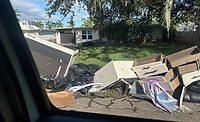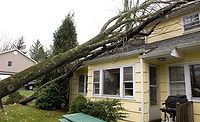Zero Hour
Roofers Brace for High Demand After Milton Makes Landfall
Category 3 cyclone hits terra firma Wednesday evening

Hurricane Milton made landfall Wednesday evening and reigned terror from the start. By midnight, nearly two million homes had lost power. The Associated Press reported that St. Petersburg city officials alerted residents that a broken water main had forced a temporary shut-off of drinking water service. The city issued a boil alert until service was restored.
— Image courtesy of NOAA
4 MIN READ
Roofing crews remain at the ready after Hurricane Milton made landfall as a Category 3 hurricane Wednesday night around 8:30 p.m., first roaring ashore in Siesta Key, Fla., with maximum sustained winds of 120 mph; Milton is the second cyclone to hit the Sunshine State in as many weeks.
The storm cut power to more than 1 million homes and businesses within its first hour of arrival, according to PowerOutage.us, which tracks utility reports nationwide; Milton would eventually rob more than 3 million of electricity before it was over.
Forecasters anticipated a significant storm surge in Sarasota, Tampa and the surrounding areas. Tampa Bay escaped that peril but was battered by heavy rain and winds. According to the National Hurricane Center, steady rain dumped up to 3 inches per hour; the region experienced what meteorologists described as a 1,000-year rain event before Milton headed east toward the Atlantic Ocean.
While it may take days—or longer—to assess the damage Milton and predecessor storm Helene wrought on Florida, roofing contractors know their services will be in high demand for the foreseeable future.
“Downtown Naples already has two feet of water, and it's going to be an eight-foot surge, where Ian was only six feet, and [downtown] was destroyed,” explained Brian Cooper, the director of sales and marketing at Mighty Dog Roofing in Naples, by phone on Wednesday afternoon, just hours before Milton came ashore.
“So, this is not going to be good; it's going to be another flood event from Marco Island all the way up to the Panhandle,” he added, sounding weary but resolute.
Cooper and his family are sheltered in place. Their home is south of the mandatory evacuations ordered on Tuesday. Still, the Long Island, N.Y. native knows the days and weeks ahead will be grueling, and he sounds prepared.
When asked whether he thought there might be a problem securing necessary materials — the days of scrounging for roof tile following the industry’s supply chain disruptions don’t seem that distant — he was self-assured.
“We have a stockpile in our shanty we keep and our laborers are ready to go; we have 60 workers total who are subcontractors — but they work directly for our subcontractor boss; we have the team,” Cooper said.
“We told them, do not leave town as a storm chaser. Stay here for [the residents]. And we also ran ads on our Instagram and Facebook accounts telling homeowners, neighbors and residents here in Naples, not to hire storm chases; keep it local, and we'll help out,” he added.
Cooper also mentioned Naples' unique market dynamic: By his estimate, nearly 50 percent of the homes are currently empty. According to city promotional material, snowbirds roughly double Naples’ population in the winter and typically don’t arrive for the season before the second or third week of October.
What, Me Worry?
As ominous as Milton had loomed in the country’s collective imagination ahead of Wednesday night, some remain unflappable, like industry veteran Ken Kelly — scion of Kelly Roofing, whose father, Joe Kelly, founded the firm in Naples more than a half-century ago.
It was nearly two years ago, to the day (Oct. 4, 2022), when Roofing Contractor posted a video podcast Kelly sat for with Publisher Jill Bloom to discuss the response to Hurricane Ian and what lessons were learned from that $50 billion disaster.
Fast forward 24 months, and the two spoke by phone mid-afternoon yesterday about Milton and the state-of-the-art operations center Kelly created for his firm to withstand cataclysmic storms like Ian and Milton. The facility, a former television station with a broadcast tower, receives direct feeds from area police, fire, EMS and other emergency services.
Their conversation, which I used in part for this story, included a laundry list of necessities that seem appropriate for a shelter and emergency operation center, including an alternative potable water source, gas-generated power, sufficient foodstuffs and other survivalist lore. (A line of credit couldn't hurt, either.)
One item on their verbal dance card I hadn’t thought of but could be the most useful — if not the most affordable — is Starlink, the Elon Musk-designed satellite internet connection that skirts problems like downed telephone lines and disrupted cell service.
“Starlink revolutionized our ability to use our internet-based CRM and ERP systems,” Kelly explained. “Now with Starlink, it almost doesn't matter that you don't have internet, because we can get internet anywhere we have power with the new Starlink minis.”
Kelly said Starlink can run off portable batteries like those that charge cell phones and last up to eight hours. According to the company website, the Starlink Mini retails for $499.
“So, it's really easy, and because it has its own Wi-Fi router, everybody in the office just connects to that one router, and speeds are pretty good,” he told Bloom.
Trent Cotney, RC legal columnist and a partner at Adams and Reese in Tampa, offered sage advice for roofing contractors on how to navigate a challenging environment following Hurricane Ian.
“Come prepared, there is no water, there is no food, there is no power,” said Cotney. “If you plan on staying down here and you’re not within driving distance, make sure you figure out somewhere for your crews to stay because it is utter destruction down there.”
Looking for a reprint of this article?
From high-res PDFs to custom plaques, order your copy today!






